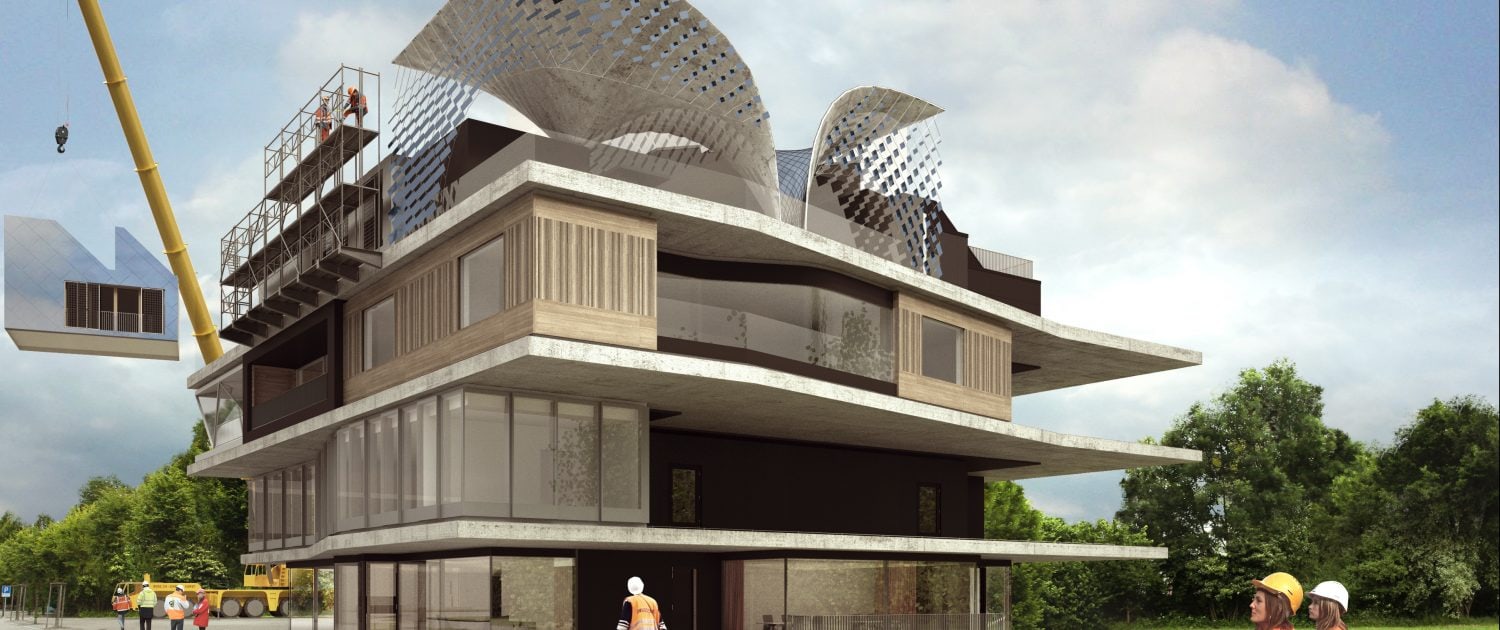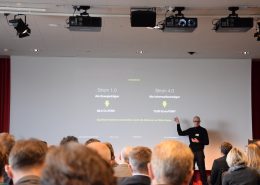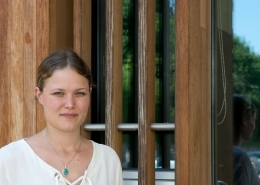As majestic alpine profiles come into full view, Daniel Lepori, CEO of Designergy, a building-integrated photovoltaics (BIPV) manufacturer, warns us as we glide onto the highway on-ramp, “Keep your heads up against the headrest, unless you want to bruise your brain.” But suddenly Nico Lauer and I find ourselves traveling over 100 km (? 62 miles) per hour – all in 3.2 neck-snapping seconds. Absent was the growling baritone of the Ferrari Testarossa. Instead, with noiseless efficiency the electric power generated by 362 horsepower directed all of its torque directly to the wheels of this Tesla Model S.
So began a journey that offered us a glimpse of a future where renewable energy can be abundantly available with little sacrifice of quality of life. Touring university labs, prototypical projects, and other noteworthy sites was part of the three day “Swiss-US Innovation Days” conference, held August 19-21 in Zürich. Sponsored mostly by Swiss government agencies, universities and corporations, and the Massachusetts Clean Energy Center, this event brought together over 300 guests and delegates from both countries to focus on encouraging innovation in renewable energy and integrated building systems. The goal was to generate policy recommendations to realize the technical and economic potential of the ongoing “great energy transition” (see Lester Brown’s “The Great Transition”) to cleaner energy systems. Attendees came from highly varied fields: academic, science and technology research, government and public policy, business and finance, real estate, and, of course, design and construction. The result of this Swiss mix was a lively, captivating perspective of what is possible now and in the not-so distant future. The conference also highlighted the challenges both countries face in realizing the full potential of these sustainable strategies and policies. An overview of the conference follows, as well as the issues and challenges these changes raise. (See http://www.energyinnovationdays.com/)
Future Green Vignettes
Imagine a building made of four concrete floor slabs, each supporting several self-sustaining units. Each unit encompasses the latest technologies and strategies for reducing energy consumption, generating surplus energy, and optimizing energy use by providing residents and users easy-to-use tools in their daily lives. Designed as sort of a 21st century “Dom-ino house”, the NEST project’s building platform and core enables companies and institutions to test new ideas in a living laboratory, accelerating innovation’s entry into the marketplace. The brainchild of Dr. Peter Richner, this futuristic project is built on the campus of EMPA, a quasi-public institute for materials science research supported in part by corporate partners, this project is scheduled to come online in 2016.
Imagine a cabin not much bigger than Henry David Thoreau’s Walden Pond cabin, but entirely self-sufficient: it generates its own energy and collects and processes water and waste. It is deftly designed so that every interior and exterior element serves multiple functions while providing a comfortably cozy living space. Hitchable to an electric car, the cabin can be taken to sites urban or remote. Handsomely designed and packed with high-tech systems, this Swiss cabin would make Thoreau jealous. (http://library.eawag-empa.ch/empa_berichte/EMPA_Bericht_212.pdf)
Imagine solar cells so thin (0.50-0.70 mm – the thickness of a few human hairs) they can be applied to thin / flexible substrate. This new EMPA -developed product uses polymer film and is malleable enough to be turned into coats, capes or other prêt-à-porter fashion items. Better yet, the possibility of introducing colors (besides black) into this product excites designers about how these surfaces can become part of our living environment. Best of all, this product set a world record for solar efficiency, capturing 20.4% of the sun’s energy.
Imagine a new mixed-use community that is entirely zero-energy and adjacent to fast, convenient public transit. Scale is often hard to achieve in zero-energy construction, especially as the building types get taller, denser and more complex. Yet this 1 million SF project, developed by Zug Estates in Zug, 22 km south of Zürich, achieves this goal, thanks in part to its advanced geothermal systems. During the winter, heat is drawn from the earth to heat apartments and offices. In the summer, heat is taken out of the apartments and pumped back into the earth, thus maintaining a delicate thermo-dynamic balance below grade. This is not only ecologically sound, but also extends the life of the geothermal system itself.
Imagine older housing renovated in slickly designed solar skins, generating sufficient energy to be free of the grid. The community’s fabric and scale are maintained, while new life is infused into urban neighborhoods. For this purpose, Karl Viridén of Viridén + Partner AG has also created a special revolving, investor-supported development fund, where profits from one green renovation fund the next project, and projects increase in size. As this model is more widely accepted, its investment risk is reduced. In fact, this model raises the question whether it is riskier to develop projects that do not use renewable energy or reduce long-term energy costs (www.EcoRenova.ch).
Imagine buildings wrapped in surfaces that not only provide building skins’ typical benefits – e.g., protection from the elements – but also generate and save energy. Two new sets of products do this in clever, elegant ways. The Solar Activated Façade (SAF) developed by Lucido is a beautiful wall panel system with an R value of over 150, and sometimes over 200. Made of glass and elegantly natural and sustainable wood strips, this product has an integrated ventilated air space between the exterior glass surface and the custom-milled wood panels. Air circulates in this space to optimize the temperature delta between exterior and interior conditions. A BIPV roof system, as designed by Designergy, simplifies roof construction and PV installation by integrating the entire roof assembly (structure, insulation, roof membrane) with the PV panels and its ancillary components. Contractors love it for its ease of use, while clients enjoy the slick, streamlined appearance of its roof: the solar panels blend seamlessly into the neighborhood roofscape.
Imagine new lithium batteries that are five times more efficient, thanks to figuring out an older lithium-ion technology developed out of the cobalt-oxide cathode in 1980 by solid-state physicist John Bannister Goodenough. This would allow cars to go five times as far on the same battery size, or reduce the weight of a car’s battery by four-fifths, which in turn improves performance while lowering cost. Young researchers at IBM’s Zürich center are dreaming up cutting-edge ideas like this. Other enticing research efforts include Quantum and Neuromorphic Computation (Memory + Computation). These new advances in computational power will give us even more efficient tools to manage big data and complex urban systems, allowing us to better utilize our natural and financial resources.


 BFEVon Reden für den Direktor, Bürgerschreiben und Kopfwehtabletten
BFEVon Reden für den Direktor, Bürgerschreiben und Kopfwehtabletten  „Data is the new oil”
„Data is the new oil”  Was man alles sagen könnte
Was man alles sagen könnte  SwisspowerUrban Blockchain Summit: Wieviel Regulierung braucht es?
SwisspowerUrban Blockchain Summit: Wieviel Regulierung braucht es? 


Dein Kommentar
An Diskussion beteiligen?Hinterlassen Sie uns Ihren Kommentar!